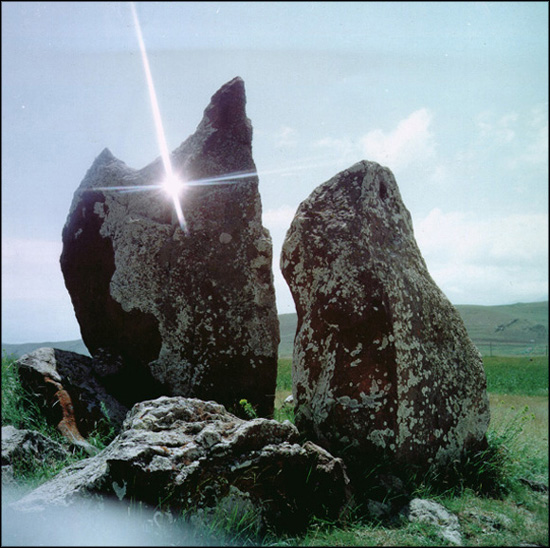
From the Siberian mountains of Ural to the Sub-Saharan Africa, from the Sub-Tropical jungles of Peru to the warm shores of the Mediterranean/Adriatic, from the highest tops of the Himalayas to the soaring twins of the Mt. Ararat, the beginning of the first human civilization have been pre-supposed. But the highly sophisticated archaic ruins of the Mestamor, lying at the heart of the Armenian Highland emerged to be the most likely of them all.
Extensive archeological finds of obsidian instruments roughly fashioned by the primitive man indicate ancient human settlements in Armenia, dating back to the Old Stone Age (Abbevillian culture) and further onwards. Thus, the archaic history of the human race begins to unravel in Armenia, dating back to 500,000 years ago.
The earliest civilization that has been found in Armenia, and is believed to be the first in the world is the Metsamor Civilization, which is dating back to around 5,000 BCE. The ancient capital of the Metsamor kingdom is located on the area of 26 acres, which consists of a cyclopic stonewalls, citadel within them and a vast cosmic observatory. The fortress of Metsamor is further enhanced by a large series of oval shaped dwellings along with adjacent buildings and an underground tunnels.
The "heavenly" knowledge of metal processing thought to be received from the pre-deluvial "gods" of the ancients was the most sophisticated of its kind ever found to be of that time period. Metsamor was known to have processed a high-grade gold, copper, and various types of bronze, strychnine, manganese, zinc, mercury and iron. Metal goods made in the Metsamor were highly valued and widely known by its surrounding cultures, stretching out as far as Central Asia, Chine, India and Egypt.
Around 11BCE, Metsamor city-capital grew to occupy 247 acres of land, extending itself up to the Lake Akna. Some 500 m. southwest of the citadel, archeologists have found another stretch of land, about 247 acres big, hosting ancient dwellings enough to accommodate about 75, 000 people. A city of such size rivaled any those of the archaic world.
Another swat of land, around 200 acres big, located next to the city constitutes to be the main burial ground of the archaic Metsmorians, where archeologists have managed to retrieve the remnants of 30, 000 people. Very interesting commonality with the Egyptians that Metsamorians had was to burry the rich and noble people separately, just like the Valley of the Kings in Egypt. However, such distinction have helped to avoid grave robbers, thus providing scholars with a significant amount of information into the traditions and burial rights of the deceased on their way to the afterlife.
Armenia's Fertile Crescent was located in the land between rivers, the famous Tigris and Euphrates, further encompassing the land behind the Arax River. However, within the Ararat valley, a much smaller crescent of land still bearing the marshland once covering the entire Ararat Valley is found. One of the oldest settlements found in Armenia, beyond Erevan extend to the caves and stone-inscriptions found on the Geghama Ler (Mt), where only few sites have so far been excavated.
The metal ore mined in Armenia was the purest in the world that resulted in the formation of a culture, where the use of metal idols and building of temples made out of metal have been widely practiced. Their complex cosmic observatories made out of stone stood proudly, charting the vastness and enormity of the nightly sky.
Since time immemorial, humans have pondered their origins. Throughout history many cultures have held various beliefs on the subject. Theorizing and believing everything from stellar origins, to creation in the heavens. All such curiosity and speculation has fueled mankindís ancient curiosity and interest for astronomy.
The earliest signs of astronomic study in Armenia date back to the copper-bronze Ages (5000-2000BCE). They are found at the archeological sites of Metsamor and Geghama Ler. Pictograms and highly complex celestial iconography along with the early Zodiac sings carefully inscribed on the rocks of Geghama Ler and the ancient dwellings of the Metsamorians.
Furthermore, two major observatories found at the excavation sites indicate a highly developed astronomic awareness of the ancient Armenians, who decorated the sites with lithographic representations of various constellations as well as a calendar consisting of 365 days.
The first observatory found at the Metsamor site has a definite orientation towards a bright star, now known as Sirius. It is suggested, due to evidence collected at this site, that inhabitants of Metsamor celebrated the beginning of the new year with the spring solstice. As well, various inscriptions found at the observatory coincide with modern western zodiac signs of the Aries, Capricorn, Leo and Taurus. There is even work that very strongly indicates that these ancient Armenians envisioned the earth as a sphere.
Very little has been learned about ancient Armenian civilization as relatively little archeological work has been undertaken. Also, much knowledge has been lost forever due to mishandling and even state-sponsored vandalism and demolition of ancient Armenian sites which lie outside of Armeniaís current borders.
"Evolution of the World Alphabets", by Dr.Armen Melkonyan
"In the World of Laws and Measurments", by Dr.Suren Aivazyan
"From the History of Ancient Armenia", by Dr.Suren Aivazyan
"The History of Armenian People", by Dr. Leon Babakhanyan
"The Armenian History", by Armenia's National Accademy of Sciences (1971)
HAYK National Institute (www.arminco.com/Armenia/haik.html) (http://www.arminco.com/hayknet/cult-e.htm)